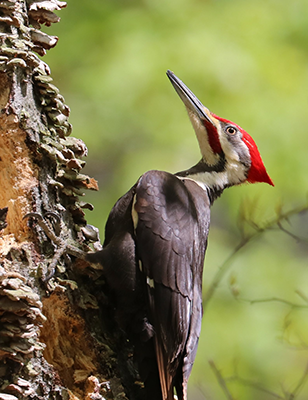Woodpeckers of Westchester: A Portentous Pileated
 By Brian Kluepfel
By Brian Kluepfel
We have considered the pileated woodpecker a bird of good fortune since we saw one just outside our apartment on moving day four years ago.
Such a massive, beautiful creature, we were compelled to watch, even as the rain drizzled down our necks and dampened our hair on a dank March morning. I even asked the landlord not to remove the tree where the woodpecker was situated. The tree is still there, but probably not due to my request.
As big and bodacious as the pileated woodpecker is (if you haven’t seen one, they’re crow-sized, with a bright red crest), they’re not easy to spot, especially in the spring and summer. They tend to be high up in the canopy of thick woods, and eastern deciduous forests are dense with foliage until late autumn. While we often hear one on our walks through Mariandale, only once have we seen one there. We did see another, out in the open by the Ossining Metro-North station, a few years ago.

On New Year’s Eve I met a good friend at Pruyn Sanctuary for a coffee and a quick hike. (It was another drizzly day.) As we strolled through the lowland swamp, we heard the unmistakable tapping of a woodpecker, and a loud tapping at that. After inspecting the treetops for a moment, my friend spied the pileated woodpecker, and pointed it out to me. I had the advantage of binoculars and got a good view; a nice way to end the year.
I kidded with my friend that the American Birding Association was naming its Bird of the Year that night at 10 p.m. and that he should stay up for the announcement. We had a good laugh and went our separate ways, driving into the mists of 2021.
To my delight, on New Year’s morning I read that the pileated woodpecker had been named Bird of the Year. It was almost like the previous day’s sighting was a portent. Maybe a good sign in dark times. Perhaps as the woodpecker raps its head repeatedly against the trunk to get a reward of insects, collective humanity bashing our head against the wall of intolerance and misunderstanding will result in something positive. Or maybe we’ll have to fly to another tree.
There are 22 woodpecker species native to North America (for die-hards who insist the ivory-billed is still around, 23). You can see several at our Saw Mill River Audubon sanctuaries in Westchester. Among them are the red-bellied woodpecker (we just saw one at Cedar Lane Park), the hairy woodpecker, the downy woodpecker, the northern flicker (often visible on the ground, with gilt-edged wings), the yellow-bellied sapsucker, and naturally, the pileated woodpecker. In recent years, Muscoot Farm in Somers had been home to a nest of stunning red-headed woodpeckers.
Brian Kluepfel is the editor of the Saw Mill River Audubon newsletter and a correspondent for Lonely Planet and Fodor’s travel guides, as well as Birdwatching and Westchester magazines. You can find him at birdmanwalking.com and @briankluepfel on social media.


